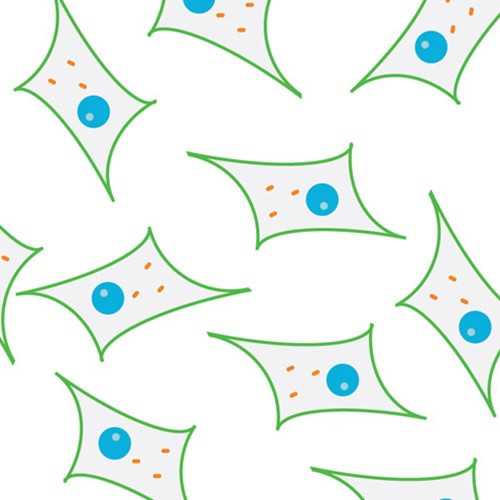Heparan Sulfate Mutant Mouse Lung Endothelial Cell Lines
These heparan sulfate (HS) mutant mouse lung endothelial cell lines (MLEC) were generated by transiently transducing the immortalized wildtype mother
mouse lung endothelial cell line which harbors conditionally targeted Ext1f/f, Ndst1f/f, Ndst1f/f;Ndst2-/-, Hs2stf/f, Hs6st1f/f, Hs6st1f/f;Hs6st2-/- and Sulf1f/f;Sulf2f/f genes followed by cell cloning.
Highlights:
- Clones available: Ext1f/f, Ext1-/-, Ndst1f/f, Ndst1-/-, Ndst1f/f;Ndst2-/-, Glce-/-, Hs2st1f/f, Hs2st1-/-, Hs6st1f/f, Hs6st1-/-, Hs6st1f/f;Hs6st2-/-, Hs6st1-/-;Hs6st2-/-, Hs3st1-/-, Hs3st4-/-, Hs3st1-/-;Hsst4-/-, Sulf1f/f;Sulf2f/f, Sulf1-/-;Sulf2-/-
- Useful for studying the role of heparan sulfate (HS) in a cellular context
- May prove helpful for future heparan sulfate (HS)-antibody based research
Heparan sulfate (HS) is a linear polysaccharide found in all animal tissues that occurs as a proteoglycan (HSPG, i.e. Heparan Sulfate ProteoGlycan). HS binds to a variety of protein ligands, including Wnt, when its two or three chains are attached in close proximity to cell surface or extracellular matrix proteins. In addition to protein ligand binding, HS has a role in regulating a number of biological processes, such as developmental, as well as angiogenesis, blood coagulation, abolishing detachment activity by GrB and tumor metastasis. Based on a number of studies, it was shown that this polysaccharide can also serve as a cellular receptor for certain viruses (such as syncytial virus and possibly has a role in SARS-CoV-2 infection).
From the laboratory of Lianchun Wang, MD*, University of Georgia.
*Now affiliated with Georgia Institute of Technology.
These heparan sulfate (HS) mutant mouse lung endothelial cell lines (MLEC) were generated by transiently transducing the immortalized wildtype mother
mouse lung endothelial cell line which harbors conditionally targeted Ext1f/f, Ndst1f/f, Ndst1f/f;Ndst2-/-, Hs2stf/f, Hs6st1f/f, Hs6st1f/f;Hs6st2-/- and Sulf1f/f;Sulf2f/f genes followed by cell cloning.
Highlights:
- Clones available: Ext1f/f, Ext1-/-, Ndst1f/f, Ndst1-/-, Ndst1f/f;Ndst2-/-, Glce-/-, Hs2st1f/f, Hs2st1-/-, Hs6st1f/f, Hs6st1-/-, Hs6st1f/f;Hs6st2-/-, Hs6st1-/-;Hs6st2-/-, Hs3st1-/-, Hs3st4-/-, Hs3st1-/-;Hsst4-/-, Sulf1f/f;Sulf2f/f, Sulf1-/-;Sulf2-/-
- Useful for studying the role of heparan sulfate (HS) in a cellular context
- May prove helpful for future heparan sulfate (HS)-antibody based research
Heparan sulfate (HS) is a linear polysaccharide found in all animal tissues that occurs as a proteoglycan (HSPG, i.e. Heparan Sulfate ProteoGlycan). HS binds to a variety of protein ligands, including Wnt, when its two or three chains are attached in close proximity to cell surface or extracellular matrix proteins. In addition to protein ligand binding, HS has a role in regulating a number of biological processes, such as developmental, as well as angiogenesis, blood coagulation, abolishing detachment activity by GrB and tumor metastasis. Based on a number of studies, it was shown that this polysaccharide can also serve as a cellular receptor for certain viruses (such as syncytial virus and possibly has a role in SARS-CoV-2 infection).
From the laboratory of Lianchun Wang, MD*, University of Georgia.
*Now affiliated with Georgia Institute of Technology.
| Catalog Number | Product | DataSheet | Size | AVAILABILITY | Price | Qty |
|---|
| Product Type: | Cell Line |
| Name: | Ext1f/f, Ext1-/-, Ndst1f/f, Ndst1-/-, Ndst1f/f;Ndst2-/-, Glce-/-, Hs2st1f/f, Hs2st1-/-, Hs6st1f/f, Hs6st1-/-, Hs6st1f/f;Hs6st2-/-, Hs6st1-/-;Hs6st2-/-, Hs3st1-/-, Hs3st4-/-, Hs3st1-/-;Hsst4-/-, Sulf1f/f;Sulf2f/f, Sulf1-/-;Sulf2-/- |
| Cell Type: | Mouse lung endothelial cells |
| Morphology: | Cobble stone like |
| Organism: | Mouse |
| Source: | Lung |
| Biosafety Level: | BSL 1 |
| Growth Conditions: | High-glucose DMEM supplemented with 20% FBS, 30 ug/ml endothelial cell growth supplement and 50 ug/ml heparin. |
| Subculturing: | 1:3 split, Doubling every 3-4 days |
| Cryopreservation: | Media + 10% DMSO |
| Storage: | Liquid Nitrogen |
| Shipped: | Dry Ice |
From the laboratory of Lianchun Wang, MD*, University of Georgia.
*Now affiliated with University of South Florida.
- Qiu H, Shi S, Yue J, et al. A mutant-cell library for systematic analysis of heparan sulfate structure-function relationships. Nat Methods. 2018;15(11):889-899.
- Capicciotti CJ, Zong C, Sheikh MO, Sun T, Wells L, Boons GJ. Cell-Surface Glyco-Engineering by Exogenous Enzymatic Transfer Using a Bifunctional CMP-Neu5Ac Derivative. J Am Chem Soc. 2017;139(38):13342-13348.
- Guo C, Fan X, Qiu H, Xiao W, Wang L, Xu B. High-resolution probing heparan sulfate-antithrombin interaction on a single endothelial cell surface: single-molecule AFM studies. Phys Chem Chem Phys. 2015;17(20):13301-13306.
- Qiu H, Jiang JL, Liu M, Huang X, Ding SJ, Wang L. Quantitative phosphoproteomics analysis reveals broad regulatory role of heparan sulfate on endothelial signaling. Mol Cell Proteomics. 2013;12(8):2160-2173.
If you publish research with this product, please let us know so we can cite your paper.


